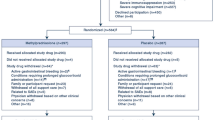Abstract
The aim of this prospective, double-blinded pilot trial study was to evaluate the effects of Thymosin alpha 1 use in the early phase on immunomodulation and clinical outcomes in patients with severe acute pancreatitis (SAP). A total of 24 patients with SAP were randomized to receive either conventional therapy for SAP or immunomodulatory therapy (TA1 group). The patients in the thymosin group were injected with Talpha1 3.2 mg twice per day for 7 days. The serum level of HLA-DR and CD4/CD8 ratio and other immune parameters were measured on admission, the 8th day and the 28th day. There was a low expression of monocyte HLA-DR in both groups on admission, and more rapid alterations in the HLA-DR were found in the TA1 group. The positive rates of blood and abdominal drainage culture were statistically significant during the 28th follow-up period. The duration of ICU stay was shorter after TA1 treatment. Improves cell-induced immunity and reduces infection rate in severe acute pancreatitis patients.
Similar content being viewed by others
References
Farkas, G., J. Marton, Y. Mandi, et al. 1996. Surgical strategy and management of infected pancreatic necrosis. The British Journal of Surgery 83: 930–933.
Isenmann, R., B. Rau, and H.G. Beger. 1999. Bacterial infection and extent of necrosis are determinants of organ failure in patients with acute necrotizing pancreatitis. The British Journal of Surgery 86: 1020–1024.
Christophi, C., F. McDermott, and E.S. Hughes. 1985. Prognostic significance of the absolute lymphocyte count in acute pancreatitis. American Journal of Surgery 150: 295–296.
Curley, P.J., M.J. McMahon, F. Lancaster, et al. 1993. Reduction in circulating levels of CD4-positive lymphocytes in acute pancreatitis: relationship to endotoxin, interleukin 6 and disease severity. The British Journal of Surgery 80: 1312–1315.
Pezzilli, R., P. Billi, E. Beltrandi, et al. 1995. Circulating lymphocyte subsets in human acute pancreatitis. Pancreas 11: 95–100.
Widdison, A.L., and S. Cunningham. 1996. Immune function early in acute pancreatitis. The British Journal of Surgery 83: 633–636.
Uehara, S., K. Gothoh, H. Handa, et al. 2003. Immune function in patients with acute pancreatitis. Journal of Gastroenterology and Hepatology 18: 363–370.
Yao, W., Q. Zhu, Y. Yuan, et al. 2007. Thymosin alpha 1 improves severe acute pancreatitis in rats via regulation of peripheral T cell number and cytokine serum level. Journal of Gastroenterology and Hepatology 22: 1866–1871.
Takeyama, Y., J. Nishikawa, T. Ueda, et al. 1998. Thymic atrophy caused by thymocyte apoptosis in experimental severe acute pancreatitis. The Journal of Surgical Research 78: 97–102.
Yasuda, T., Y. Takeyama, T. Ueda, et al. 2002. Splenic atrophy in experimental severe acute pancreatitis. Pancreas 24: 365–372.
Takeyama, Y., K. Takas, T. Ueda, et al. 2000. Peripheral lymphocyte reduction in severe acute pancreatitis is caused by apoptotic cell death. Journal of Gastrointestinal Surgery 4: 379–387.
Bradley 3rd, E.L. 1993. A clinically based classification system for acute pancreatitis. Summary of the International Symposium on Acute Pancreatitis, Atlanta, Ga, September 11 through 13, 1992. Archives of Surgery 128: 586–590.
Li, Y., H. Chen, X. Li, et al. 2009. A new immunomodulatory therapy for severe sepsis: Ulinastatin Plus Thymosin alpha 1. Journal of Intensive Care Medicine 24: 47–53.
Romani, L., F. Bistoni, C. Montagnoli, et al. 2007. Thymosin alpha1: an endogenous regulator of inflammation, immunity, and tolerance. Ann N Y Acad Sci 1112: 326–338.
Ueda, T., Y. Takeyama, T. Yasuda, et al. 2006. Immunosuppression in patients with severe acute pancreatitis. Journal of Gastroenterology 41: 779–784.
Gotzinger, P., T. Sautner, A. Spittler, et al. 2000. Severe acute pancreatitis causes alterations in HLA-DR and CD14 expression on peripheral blood monocytes independently of surgical treatment. The European Journal of Surgery 166: 628–632.
Kylanpaa-Back, M.L., A. Takala, E. Kemppainen, et al. 2001. Cellular markers of systemic inflammation and immune suppression in patients with organ failure due to severe acute pancreatitis. Scandinavian Journal of Gastroenterology 36: 1100–1107.
Richter, A., T. Nebe, K. Wendl, et al. 1999. HLA-DR expression in acute pancreatitis. The European Journal of Surgery 165: 947–951.
Mentula, P., M.L. Kylanpaa-Back, E. Kemppainen, et al. 2003. Decreased HLA (human leucocyte antigen)-DR expression on peripheral blood monocytes predicts the development of organ failure in patients with acute pancreatitis. Clin Sci (Lond) 105: 409–417.
Knutsen, A.P., J.J. Freeman, K.R. Mueller, et al. 1999. Thymosin-alpha1 stimulates maturation of CD34+ stem cells into CD3 + 4+ cells in an in vitro thymic epithelia organ coculture model. International Journal of Immunopharmacology 21: 15–26.
Satoh, A., T. Miura, K. Satoh, et al. 2002. Human leukocyte antigen-DR expression on peripheral monocytes as a predictive marker of sepsis during acute pancreatitis. Pancreas 25: 245–250.
Author information
Authors and Affiliations
Corresponding author
Additional information
An erratum to this article can be found at http://dx.doi.org/10.1007/s10753-011-9315-7
Rights and permissions
About this article
Cite this article
Wang, X., Li, W., Niu, C. et al. Thymosin Alpha 1 is Associated with Improved Cellular Immunity and Reduced Infection Rate in Severe Acute Pancreatitis Patients in a Double-Blind Randomized Control Study. Inflammation 34, 198–202 (2011). https://doi.org/10.1007/s10753-010-9224-1
Published:
Issue Date:
DOI: https://doi.org/10.1007/s10753-010-9224-1




